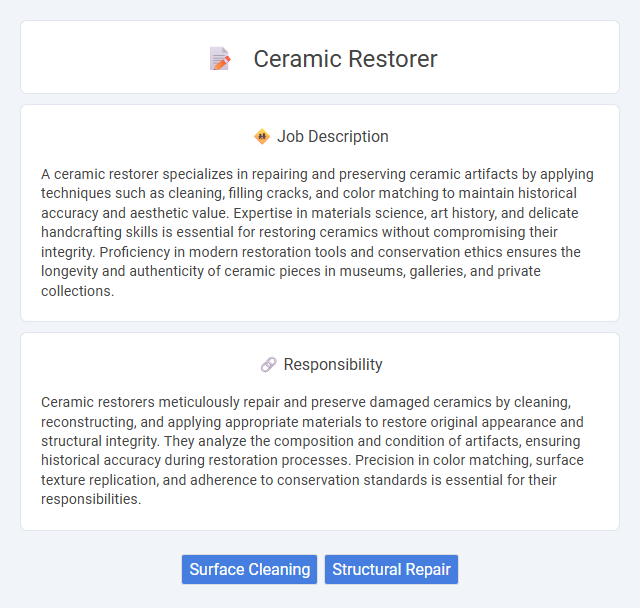
A ceramic restorer specializes in repairing and preserving ceramic artifacts by applying techniques such as cleaning, filling cracks, and color matching to maintain historical accuracy and aesthetic value. Expertise in materials science, art history, and delicate handcrafting skills is essential for restoring ceramics without compromising their integrity. Proficiency in modern restoration tools and conservation ethics ensures the longevity and authenticity of ceramic pieces in museums, galleries, and private collections.
People with a keen eye for detail and steady hands are likely suitable for a ceramic restorer position, as the role involves repairing delicate and often antique items. Those who may struggle with patience or fine motor skills might find the job challenging, given the precision required in restoration tasks. Individuals with a background or interest in art, history, or craftsmanship probably have a higher probability of succeeding and feeling fulfilled in this career.
Qualification
A ceramic restorer must possess expertise in material science, fine arts, and conservation techniques, complemented by a degree or certification in restoration or archaeology. Proficiency in handling delicate ceramics, knowledge of historical art styles, and skills in advanced chemical analysis for identifying materials are essential. Experience with modern restoration tools, attention to detail, and an understanding of ethical preservation standards ensure high-quality restoration results.
Responsibility
Ceramic restorers meticulously repair and preserve damaged ceramics by cleaning, reconstructing, and applying appropriate materials to restore original appearance and structural integrity. They analyze the composition and condition of artifacts, ensuring historical accuracy during restoration processes. Precision in color matching, surface texture replication, and adherence to conservation standards is essential for their responsibilities.
Benefit
Working as a ceramic restorer likely offers benefits such as enhanced artistic skills and a deep understanding of material science, which can increase job satisfaction and marketability. There is probably a chance for financial gain through specialized projects or restoration commissions that value detailed craftsmanship. Opportunities for collaboration with museums and collectors could also provide professional networking advantages and career growth.
Challenge
Ceramic restorers likely face the challenge of meticulously repairing fragile pieces without compromising their original aesthetic or historical value. The probability of encountering complex damage such as fine cracks or missing fragments may require advanced techniques and patience. Skill in color matching and texture replication probably plays a critical role in achieving seamless restoration results.
Career Advancement
A career as a ceramic restorer offers opportunities for specialization in fine art preservation, museum curation, and heritage conservation. Mastery of advanced restoration techniques and materials science can lead to roles with higher responsibility, including project management and consultancy. Building a strong portfolio and professional network enhances prospects for collaboration with cultural institutions and prestigious restoration firms.
Key Terms
Surface Cleaning
Ceramic restorers specialize in surface cleaning techniques that remove dirt, stains, and oxidation from fragile ceramic materials without damaging their original glaze. Utilizing advanced methods such as micro-abrasion, chemical cleaning agents, and ultrasonic baths ensures the preservation of ceramics' historical and artistic value. Meticulous surface cleaning is essential to prepare ceramics for further restoration or display, maintaining both aesthetic appeal and structural integrity.
Structural Repair
Ceramic restorers specializing in structural repair expertly reconstruct damaged ceramic pieces by stabilizing cracks and filling missing sections with compatible materials to ensure durability and authenticity. They utilize advanced techniques such as adhesive bonding, micro-pinning, and resin infill to restore the object's original integrity while preserving its historical value. Attention to detail and knowledge of ceramic composition are crucial for achieving seamless repairs that prevent further deterioration.
 kuljobs.com
kuljobs.com